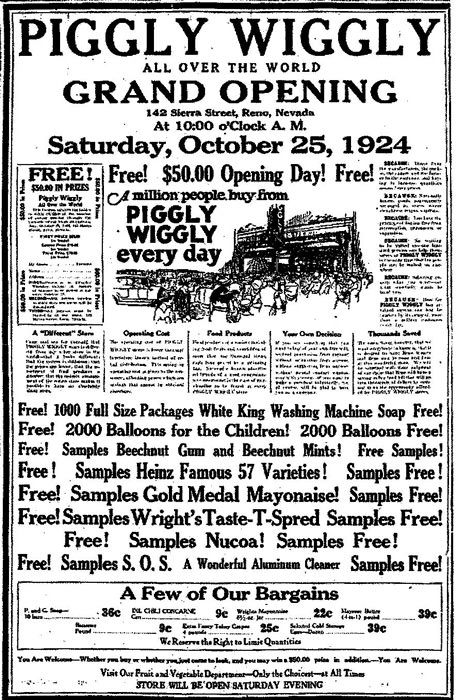edible traditions
BRINGING HOME THE BACON
Reno’s journey from mercantile to supermarket.
WRITTEN BY SHARON HONIG-BEAR
Interior of a 19th century grocery store. Courtesy of Special Collections at University of Nevada, Reno
FFood shoppers today are faced with a dizzying array of options, from scanners at checkout lines to online ordering, local and organic options, home delivery, and more. As the food shopping experience has evolved over the last century, one aspect has remained a constant: change.
Shopping before supermarkets
In the 19th century, small towns such as Reno couldn’t support large public markets such as Faneuil Hall in Boston or Pike Place in Seattle. Instead, Northern Nevadans found one-stop shops. Whether they were called general stores, mercantiles, or emporia, they were places where people could find food and necessities that otherwise were difficult to obtain.
Early Reno grocers were numerous. The Reno Mercantile/Masonic Lodge No. 13 building, at 98 W. Commercial Row, was built in 1872 and is Reno’s oldest remaining commercial structure. The first floor began as Hagerman’s Grocery, later renamed Reno Mercantile. A grocery store remained in this location for 75 years. Early stores in Reno included Berry & C. Novacovich, whose ads in the 1890s touted “all the novelties in fancy groceries … no need to send away for choice goods.” Townspeople had their favorite stores, such as Barnes Cash Grocery, Reno Bazaar, Brunetti & Patrone, Victory Market, Reno Public Market, Lincoln Market, Pinky’s Market, and more.
From shopkeeper to self-service
Big changes came in 1924 when Piggly Wiggly blasted on the scene. Started in Memphis in 1916 by Clarence Saunders, the chain revolutionized the grocery industry. Instead of placing orders with clerks, shoppers were free to move about the aisles of products and choose for themselves. When Reno’s store opened, the Nevada State Journal reported that an estimated 2,300 people attended opening day (impressive considering that Reno’s population was only about 12,000), saying, “People came back two and three times to carry away big orders. It was a good-natured crowd and purchasers knew values when they saw them.”
Other Piggly Wiggly innovations included positioning items for impulse buys, offering shopping baskets, marking prices on items, and putting employees in uniforms. The downside of the new grocery concept? It was now cash and carry, which meant the end of free delivery.

A 1924 Nevada State Journal ad for Piggly Wiggly supermarket’s grand opening in Reno
Mergers are standard
Supermarkets became a hallmark of American ingenuity, and you’d need a scorecard to follow all the mergers. Piggly Wiggly quickly expanded, and then the company fell on hard times. By 1932, Sewell United stores, already established in this area, purchased the markets for $40,000. By 1936, an announcement claimed that Piggly Wiggly would henceforward be called Sewell’s. Sewell’s continued to grow, building its flagship store at 1331 S. Virginia St. in Reno in 1959. Then in 1966, Sewell’s and Mayfair Markets merged.
In another case, the Skaggs family in Idaho created a network of 673 grocery stores and, in 1926, merged with 322 Safeway stores to become Safeway Inc. Two years later, Safeway was listed on the New York Stock Exchange, and innovations followed. In the 1930s, Safeway introduced produce pricing by the pound, adding sell-by dates on perishables, nutritional content labeling, and some of the first store parking lots.
The poster child for mergers may be Raley’s Supermarkets. Established in Placerville in 1935, the company expanded to Northern Nevada in 1973 when the Gastanaga family was selling its Eagle Thrifty Drug stores (the Gastanagas had taken over one of the Sewell’s markets in 1951, just to add another layer of complexity). The venture looked promising and, as described in the book Raley’s: A Family Store, “Our first reason for buying Eagle Thrifty was to … gain a solid marketing foothold in Nevada.”
The Raley’s team slowly adjusted to the idiosyncrasies of the new headquarters on Wells Avenue, with its 800-person bomb shelter and more nooks and crannies than a haunted mansion. The merger trend continues as Raley’s Supermarkets recently announced its acquisition of most of the area’s Scolari’s stores.
The grocery business continues to evolve, with high-tech solutions being an ongoing trend. How quaint it is then to conjure a time when technology was much simpler. As one store manager once said, all he needed was a Garvey price marker, a pencil, and a box cutter to run a supermarket, not even electricity.
Sharon Honig-Bear was the longtime restaurant writer for the Reno Gazette-Journal. She is a tour leader with Historic Reno Preservation Society and founder of the annual Reno Harvest of Homes Tour. You can reach her with comments and story suggestions at Sharon@ediblerenotahoe.com.


